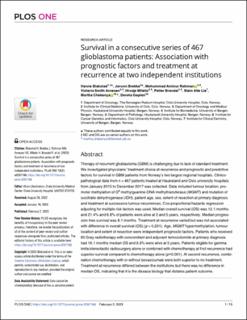| dc.contributor.author | Blakstad, Hanne Kristin | |
| dc.contributor.author | Brekke, Jorunn | |
| dc.contributor.author | Rahman, Mohummad Aminur | |
| dc.contributor.author | Arnesen, Victoria Smith | |
| dc.contributor.author | Miletic, Hrvoje | |
| dc.contributor.author | Brandal, Petter | |
| dc.contributor.author | Lie, Stein Atle | |
| dc.contributor.author | Enger, Martha | |
| dc.contributor.author | Goplen, Dorota | |
| dc.date.accessioned | 2024-04-18T12:01:32Z | |
| dc.date.available | 2024-04-18T12:01:32Z | |
| dc.date.created | 2023-06-01T13:23:57Z | |
| dc.date.issued | 2023-02-02 | |
| dc.identifier.issn | 1932-6203 | |
| dc.identifier.uri | https://hdl.handle.net/11250/3127256 | |
| dc.description.abstract | Therapy of recurrent glioblastoma (GBM) is challenging due to lack of standard treatment. We investigated physicians’ treatment choice at recurrence and prognostic and predictive factors for survival in GBM patients from Norway’s two largest regional hospitals. Clinicopathological data from n = 467 patients treated at Haukeland and Oslo university hospitals from January 2015 to December 2017 was collected. Data included tumour location, promoter methylation of O6 methylguanine-DNA methyltransferase (MGMT) and mutation of isocitrate dehydrogenase (IDH), patient age, sex, extent of resection at primary diagnosis and treatment at successive tumour recurrences. Cox-proportional hazards regression adjusting for multiple risk factors was used. Median overall survival (OS) was 12.1 months and 21.4% and 6.8% of patients were alive at 2 and 5 years, respectively. Median progression-free survival was 8.1 months. Treatment at recurrence varied but was not associated with difference in overall survival (OS) (p = 0.201). Age, MGMT hypermethylation, tumour location and extent of resection were independent prognostic factors. Patients who received 60 Gray radiotherapy with concomitant and adjuvant temozolomide at primary diagnosis had 16.1 months median OS and 9.3% were alive at 5 years. Patients eligible for gamma knife/stereotactic radiosurgery alone or combined with chemotherapy at first recurrence had superior survival compared to chemotherapy alone (p<0.001). At second recurrence, combination chemotherapy with or without bevacizumab were both superior to no treatment. Treatment at recurrence differed between the institutions but there was no difference in median OS, indicating that it is the disease biology that dictates patient outcome. | en_US |
| dc.language.iso | eng | en_US |
| dc.publisher | PLoS | en_US |
| dc.rights | Navngivelse 4.0 Internasjonal | * |
| dc.rights.uri | http://creativecommons.org/licenses/by/4.0/deed.no | * |
| dc.title | Survival in a consecutive series of 467 glioblastoma patients: Association with prognostic factors and treatment at recurrence at two independent institutions | en_US |
| dc.type | Journal article | en_US |
| dc.type | Peer reviewed | en_US |
| dc.description.version | publishedVersion | en_US |
| dc.rights.holder | Copyright 2023 the authors | en_US |
| dc.source.articlenumber | e0281166 | en_US |
| cristin.ispublished | true | |
| cristin.fulltext | original | |
| cristin.qualitycode | 1 | |
| dc.identifier.doi | 10.1371/journal.pone.0281166 | |
| dc.identifier.cristin | 2150836 | |
| dc.source.journal | PLOS ONE | en_US |
| dc.identifier.citation | PLOS ONE. 2023, 18 (2), e0281166. | en_US |
| dc.source.volume | 18 | en_US |
| dc.source.issue | 2 | en_US |

